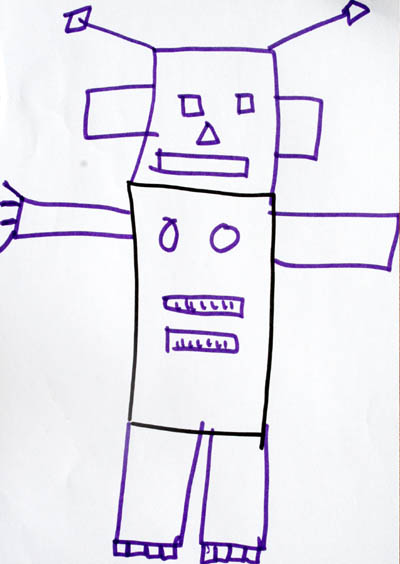Many opportunities for free drawing (with some more structured tasks) has many advantages
1 Providing children in the reception year with many opportunities for drawing allows them to refine the basic graphic skills needed for learning to print letters and numbers.
2 Drawing also allows the child to improve the motor coordination improving the needed for planning and producing the different strokes used to form letters and numbers


3 Getting involved in drawing projects trains/develops a child's ability and willingness to:
- sit and work at a project,
- explore different ways of drawing lines to create shapes and patterns
- arrange lines and shapes on a page to create a picture
Time spent drawing also helps to develop the strength and coordination in the shoulder, wrist and fingers needed for engaging in handwriting tasks.
Movement control needed for drawing and handwriting includes:
Using shoulder/elbow actions for drawing long lines, and moving the hand across the page when writing.



Using effective finger movement for drawing short lines and small shapes


|
The only way to improve finger action for handwriting is to practice drawing short lines and small shapes. Other fine motor tasks will not do the trick. This is because motor learning and strength training are very specific - you learn and improve on tasks that you practice. This is called training specificity. |
Drawing practice improves the basic graphic abilities needed for learning to print letters and numbers
Take a look at the picture below, drawn by Max in kindergarten. You will see many different graphic elements drawn with a fair amount of precision, that are well spaced and sized and have several fluent short and long lines in many directions.

Max's drawing incorporates all the graphic elements needed for learning to print letters and numbers.
- long and short lines in different directions;
- small well formed circles and other shapes;
- fairly accurate sizing and spacing of lines and shapes;
In addition Max planned the placement and size of the different elements before he started the drawing so that the pirate ship fits onto the page
This next picture was drawn Mary who has poor graphic abilities and associated coordination difficulties. Long lines are jagged, spacing is poor with crowding and overlapping of lines, and sizing is erratic.

Drawing a Z inside a small box
The term basic graphic abilities refers to the child's ability to draw straight and curved lines of different lengths and curvatures, in different directions and in different positions on the page to produce a desired outcome.
- having an idea of the desired outcome (a goal);
- translating the idea into a motor plan;
- translating the motor plan into a commands to the muscles to produce the movements required to achieve the goal.


The basic graphic abilities
1 The ability to draw relatively smooth and straight lines of different lengths and in different directions
To draw a long long horizontal lines the hand holding the marker is moved across the page using a combined shoulder/elbow movement. Ben (Gr R, second term) draws relatively straight and smooth horizontal lines.





2 Ability to draw smooth curved lines and circles of different sizes
Roan (Gr R, first term) has good control over her drawing of curved shapes. The lines are smooth and confident.
This Gr R learner has difficulty drawing curved and straight line shapes with a smooth action.

3 Ability to draw/copy squares and rectangles
Children with good graphic skills can draw/copy rectangles and squares of a of a particular size and position on the page. Roan is able to copy a square and rectangles with attention to size and orientation. In this example her ability to copy a rectangle is better than her drawing of a square.


Here you see Will's (4y 6m) attempt to copy a square and a rectangle. He has good control over drawing vertical and horizontal lines, but is not able to pre-plan the length of the lines to match the example. His various attempts at drawing provide the practice he needs to translate the visual information about line length into a motor plan to reproduce the lines.

4 Ability to draw a rectangle with the eyes closed
Children with good graphic skills can draw rectangles with their eyes closed. To be able to do this the child needs to pre-plan the movements, and keep in mind the length of the first and second lines in order to complete the drawing accurately. Children who tend to rely on ongoing visual feedback to control their movements can often draw a rectangle with the eyes closed and will produce lines that are in fact straighter and more fluent when over-reliance on visual monitoring is prevented.

Will (4y 6m) also managed to draw a rectangle after two failed attempts

5 Ability to combine the basic lines and shapes
Learners with good graphic skills will combine shapes and lines to represent people, animals and objects. This involves careful planning of the size and position of the lines and shapes relative to one another.


6 Ability to draw small shapes using effective finger movements
Children with good graphic skills will incorporate small shapes into their drawings.


Children acquire the basic graphic skills through dedicated practice
Young children with good graphic skills have usually spent quite a lot of time drawing over a number of years. This experience provides the child with the necessary practice to acquire the sensorimotor control needed for drawing the basic graphic elements.
Learning to draw a circle - a case study in drawing development over several years
Children learn to draw closed curved shapes at a very early age. Circular marks are a very prominent feature of toddler drawings.
T (2 years) spiral drawings




Drawing is about pattern making
Drawing activities allow children to explore color, line curvature, length and direction, how lines can be used to draw shapes and how how shapes can be combined in different ways to make patterns and represent people, animals and objects.
Drawing helps children to develop the visual-spatial skills needed for mathematics. Pattern making is also an important aspect of developing mathematical ideas in young children.
 .
. 
Drawing provides a way to express feelings, relationships and events
Drawing provides children with ways to represent ideas, things and people, record events and express their ideas and feelings.
Lily 6 years: Daddy when he is very sick
Will 5 year: My family
Kindergarten Drawing Activities
A PDF Guide for Parents and Teachers
Enhancing Motor Coordination and Graphic Abilities Needed for Handwriting
Learning to draw and print numbers and letters is a matter of learning to control the movements of a pencil on paper to produce straight and curved lines of different lengths, in different directions, precisely located on the page and linked to create patterns, shapes and letters. (Read more about the graphic abilities children should acquire in kindergarten.)
Children with movement difficulties associated with DCD, ASD, joint hypermobility (low muscle tone) and those having a very cautious highly sensitive (anxious) nature or a diagnosis of Sensory Processing Disorder, may need a bit of extra help with guided practice opportunities to acquire the. basic motor control and graphic abilities for learning to print letters and numbers that are well formed,spaced and sized.
The drawing activities in this Kindergarten Drawing Activities book are designed to help children acquire these basic motor coordination and graphic abilities in readiness for learning to print letters and numbers.

Available to Handwriting Gym subscribers
Just $20 for a 12 month subscription Subscribe here
HWG subscribers: To access the PDF go to your account and click on the files tab.
Contents
About
How the brain controls drawing movements
Arm and finger movements for drawing
Materials
Teaching for better learning
Activities with 13 different activity sheets
Scribble pictures and wobbly monsters
Long vertical and horizontal lines
Ladders and train tracks
Circles in boxes
Diagonal lines, triangles and zigzags
Rectangles and squares
Shapes in small boxes



About the author
Pam Versfeld is a physiotherapist with many years of experience working with children who have drawing and handwriting difficulties related to developmental motor disorders such as developmental coordination disorder (DCD), ASD, joint hypermobility/ low muscle tone and ADHD and being a highly sensitive child (sometimes diagnosed as a sensory processing disorder).
Pam is also a proud grandmother who has closely observed the developing graphic abilities of several grandchildren who have spent many hours sitting and drawing at her kitchen table.



